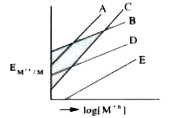Standared electrode potential of two half-reactions are given below :
Fe2+⇔Fe E∘=−0.44V,Fe3+⇔Fe2+ E∘=+0.77V
If Fe2+,Fe3+andFe are kept together : Solution in Telugu
The concentration of Fe3+ increases
The concentration of Fe3+ decreases
The mass of Fe increases
The concentration of Fe2+ increases
The correct Answer is:B, D
(1) Fe+2+2Cl−→Fe,(−0.44×2),(2)Fe+3+1e−1→Fe+2,(0.77×1)
(3)Fe+3+3e−→Fe,(∈03×3),(3)=(1)+(2)
E03=(−0.88+0.773),E03=−0.113=−0.0367V So, Fe+2/Fe,Fe+3/Fe,Fe+3/Fe+2,Fe+Fe+3⇒Fe+2+Fe+2
Topper's Solved these Questions
- BOOK - AAKASH SERIESCHAPTER - ELECTROCHEMISTRY EXERCISE - PRACTICE SHEET -5 (LINKED COMPREHENSION TYPE QUESTIONS (PASSAGE-I))3videos
ELECTROCHEMISTRY
- BOOK - AAKASH SERIESCHAPTER - ELECTROCHEMISTRY EXERCISE - PRACTICE SHEET -5 (LINKED COMPREHENSION TYPE QUESTIONS (PASSAGE-II))3videos
ELECTROCHEMISTRY
- BOOK - AAKASH SERIESCHAPTER - ELECTROCHEMISTRY EXERCISE - PRACTICE SHEET -4 (INTEGER ANSWER TYPE QUESTIONS )6videos
ELECTROCHEMISTRY
- BOOK - AAKASH SERIESCHAPTER - DILUTE SOLUTIONSEXERCISE - EXERCISE - 1.255videos
DILUTE SOLUTIONS
- BOOK - AAKASH SERIESCHAPTER - ELEMENTS OF D - BLOCKEXERCISE - EXERCISE - 5.233videos
ELEMENTS OF D - BLOCK
Similar Questions
Nernst equation gives the variation of potential of an electrode based on activity of ions temperature and pressure. The equation is
E=E∘−2.303RTnFlogQ(or)E=E∘−0.0591nlogQ
E∘= Standard potential and 'Q' is the reaction quotient.
What is the reduction potential of a hydrogen electrode in an aqueous solution containing 0.1 M NH4OH,(Kb=10−5), ?01:56View SolutionFor metal electrodes show the variation in their reduction potential as shown.

Which is the most reactive metal ?03:10View SolutionDuring electrolysis of one mole or aq HCOOK . How many moles of H2 is formed overall ?
05:27View SolutionWhat are the factor on-which solubility depends on ?
View SolutionGive some examples for the ions with pseudo inert gas electronic configuration.
05:27View SolutionGiven Ec−.Fe2+∣Fe and Ec−.Fe3+∣Fe2+ are −0.44 and 0.77V respectively.
If Fe2+,Fe3+ and Fe blocks are kept together, then [Fe3+] …………………… and [Fe2+]……………………. .03:10View SolutionStandard electrode potentials are Fe^(2+)//Fe, E^(@) = -0.44 V Fe^(3+)//Fe^(2+), E^(@) = -0.77 V If Fe^(3+), Fe^(2+) , and Fe block are kept together, then
03:10View SolutionGiven that E.Fe2+/Fe=−0.44V,E∘Fe3+/Fe2+=0.77V if Fe2+,Fe3+ and Fe solid are kept together then
View SolutionStandard electrode potential are E_(Fe^(2+)|Fe)^(@)=-0.44V,E_(Fe^(3+)|Fe^(2+))^(@)=0.77V . If Fe,Fe^(2+) and Fe^(3+) are kept together, then
02:30View SolutionStandard electrode potentials are Fe^(2+)//Fe," "E^(@)=-0.44V Fe^(3+)//Fe^(2)," "E^(@)=+0.77V Fe^(2+),Fe^(3+) and Fe blocks are kept together, then
04:17View SolutionStandard electrode potential values Fe^(2+)//Fe,E^(@)=-0.44 V , Fe^(3+)//Fe^(2),E^(@)=0.77 v If Fe^(2+),Fe^(3+) and Fe blocks are kept together it will lead to
02:32View SolutionStandard electrode potentials are
Fe2+/Fe,E∘=−0.44V
Fe3+/Fe2+,E∘=+0.77V
If Fe3+,Fe2+, and Fe block are kept together, then03:08View SolutionStandard electrode potential are given as below: Fe^(+2)//Fe,E^(o)=-0.44" " Fe^(+3)//Fe^(+2),E^(o) = 0.77 If Fe^(+2),Fe^(+3) and Fe block are kept together then which is true?
01:51View SolutionStandard electrode potentials are : Fe^(2+)|Fe(E^(@)=-0.44V).Fe^(3+)|Fe^(2+)(E^(@)=0.77V)Fe^(2+).Fe^(3+)andFe blocks are kept tigether , then
04:00View SolutionGiven that E.Fe2+/Fe=−0.44V,E∘Fe3+/Fe2+=0.77V if Fe2+,Fe3+ and Fe solid are kept together then
02:33View Solution

